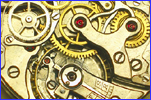

Vintage & Antique
Watch Repair
Vintage Watch Timing
While this page is written with the vintage Glycine Airman and SST watches in mind, it applies to vintage mechanical watches generally. The exception would be those watches of very high quality designed to be chronometer grade timepieces.
Currently, when one can buy, for less than $10, a quartz controlled battery powered watch that will be accurate to a few tenths of a second a day, one can be disappointed with a well-made vintage watch that is perhaps off as much as twenty seconds a day. However, going back fifty or sixty years, this was the norm.
Logically, few daily acts require the correct time to the minute, much less to the second. With a watch accurate to a minute a day, the train or the flight will not be missed assuming one has the good sense to arrive a bit early. The doctor's appointment, when one arrives on time, will still leave one in the waiting room for ten or fifteen minutes. If there is a need to know the time with great exactness, there are cell phones that receive satellite time. This time is traceable to NIST atomic clocks, and it is accurate to a second in several million years.
Readers without a watch technical background may need to refer to Wikipedia to understand the terms. Otherwise, this rather long page will become a book.
Glycine never intended Airman watches to be what may be described as super accurate even by the standards of sixty years ago. The movements used were good quality and well made, but they were not chronometer grade. A chronometer grade watch from the era of the vintage Airman would have had a Breguet (over-coil) hairspring and a micrometer adjustable regulator.
Mechanical watch timing is affected by gravity, as well as temperature, magnetic fields and even, among several other factors, barometric pressure. However, for this discussion only the effects of gravity will be considered.
Timing varies according to the position of the watch; the positions most commonly checked when adjusting a watch to time are dial up (DU), dial down (DD), and pendant (crown) down (PD). The balance wheel/hairspring assembly, which is the part of the watch that controls timing, is not isochronous. This means that the period of oscillation (timing) will vary as the balance wheel rotational amplitude varies.
Let us assume, as an example, that a balance wheel with a flat hairspring in a clean and properly lubricated vintage watch will swing an arc of 270 degrees either side of center line with the mainspring close to full wind when the watch is in either the DU or DD position. Amplitude should be the same, or very close, in either position. If the watch is placed into the PD position, the amplitude will drop because of increased friction on the balance wheel pivots. The decrease in amplitude will be, on average, about 30 degrees, or 240 degrees either side of centerline. When the amplitude drops, the timing will change, to perhaps a loss of 30 seconds a day, although this loss could be even greater. This is the isochronal error. It is possible, with skillful adjustment, to mitigate the isochronal error in a flat hairspring watch over the 270 to 240 degree amplitude range, but a residual error will almost always remain.
Because timing varies with the balance wheel amplitude, then it follows that for accurate timing, it is important to make an effort to maintain the amplitude at a high and invariable rate as is possible in all positions.
During the time the watch is being worn, with an auto winding caliber such as those used by Glycine for the Airman and SST watches, the mainspring will be close to full wind most of the day ensuring that the balance wheel amplitude will remain in the 240-270 degree amplitude range. When the watch is off the wrist, winding ceases, and as the mainspring unwinds, amplitude will decrease. If the watch is placed in the PD position overnight, the amplitude may drop below 240 degrees and the residual isochronal error will increase. Since the DU or DD positions will always have higher amplitude, there is a better chance that the amplitude will stay in the "Goldilocks" range of 240-270 degrees if the watch is put down in a dial DU or DD position. One hopes this will contribute to maintaining a better rate.
It being preferable in almost every instance to have the inevitable error on the plus side rather than the minus side, when it comes to regulation, what follows describes my method. For example, let us assume a total positional error of 15 seconds a day at a high state of mainspring wind. Be aware that there are many other factors affecting the timing besides what is described here. My goal would be to divide the error between fast and slow. This would be to regulate the watch so that 10 seconds of the error is on the plus side and the remaining 5 seconds are on the minus side, with the hope that the errors will tend to cancel out through the day, with the remaining error tending to the plus side.
The ideal goal is not necessarily achievable in actual practice. A major block to achieving the ideal is the difficulty of moving the regulator the very small amount that is required to change timing by a few seconds a day. This is why chronometer grade watches have micrometer adjustable regulators. What appears to be the slightest visible movement of the regulator can easily change the timing by 10 or 15 seconds a day.
This is a long page, but this just scratches the surface of timing. Consider an error of five seconds a day--five seconds out of the 86,400 seconds in a 24-hour day. This is an error of .006 %--not bad at all for a non-electronic device.